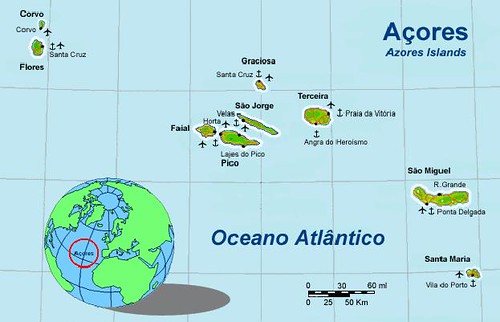The Archipelago of the Azores is a group of nine volcanic islands in the north Atlantic Ocean at the same latitude as Lisbon. They lie about 1,500 km (950 mi) from the western edge of the Iberian Peninsula and about 3,900 km (2,400 mi) from North America. Seismic activity, though rare, still occurs on occasion.It is an autonomous region of Portugal.
Population is about 250,000 with a diaspora of more than two million living overseas, primarily in the United States, Canada, Brazil, and mainland Europe. In the Channel Islands they have for long formed a substantial minority so that public phone boxes feature dialling instructions in the Azores dialect.
You should be warned, if what you are searching is a beach holiday with plenty of sun, the Azores are not right for you. However, if going to the beach is just one of the activities you will do, it should be just perfect. Climate in the Azores can vary during the day from bright sunny, to rainy and back to sunny.
Mount Pico, the highest Portuguese mountain at 2351 metres. The Azores high, an area of high atmospheric pressure, is named after the islands.
The official language in Azores is Portuguese.
ITINERARY
Fly from Lisbon to Ponta Delgada. See all 7 NM sights on Sao Miguel. Fly (on one free interconnecting flight) to Faial. See church, museum and garden in Horta. Ferry to Pico. Climb Pico Mountain. Fly or ferry to Terceira. See Town of Angra do Heroismo. Return flight to Madeira.
GET IN. The Azores are part of Portugal and thereby of the European Union and Schengen Area. Fly from Lisbon.
By plane. The main entry point is Ponta Delgada Airport (PDL) on the island of São Miguel. International airports are also on Faial, Flores (FLW), Santa Maria, Terceira islands and Pico airport (PIX).
Free connecting flight from SATA: Anyone flying from mainland Portugal, or Funchal, are eligible for a free connecting flight to any of the islands. The free flight must be arranged at least 7 days in advance and can be booked through the SATA Air Açores website.
GET AROUND
By plane. SATA Air Açores offers flights between each of the islands. The cost for each flight is capped at around €90 by the authorities. Flights are faster but more expensive than the ferry, and are the only way to travel between the eastern, western and central island groups during low season.
By ferry. Ferries connect each of the islands and are operated by Atlanticoline. There are several lines that operate:
Regular lines
Blue line – runs between Horta, Faial and Madelena, Pico
Green line – runs between Horta, Faial; Madelena, Pico and San Roque, Pico
Pink line – connects Flores and Corvo
High-season only
Yellow line – visits every island except Corvo
Purple line – runs between Sao Jorge and Terciera
The Interjovem Card limits the cost of any ferry trip to €7.50 making the ferry by far the cheapest way to travel between islands. The card is available to anyone between the ages of 13-30 and costs €40.
Once off the ferries, I plan on hitchhiking and using buses to get around each island.

SEE I have seen lots of whales and don’t plan on doing any whale watching tours. You can hike on every island but it’s best in Flores, Sao Jorge and Sao Miguel. Bikes are a great way to get to know the islands.
Itinerary: From Ponta Delgada (in São Miguel), fly to Faial. Take the boat to Pico Island. Climb Pico mountain if you are in good shape. Fly to Terceira Island.
SÃO MIGUEL
Ponta Delgada
Museu Militar dos Acores, Forte de São Brás de Ponta Delgada|
Igreja do Santo Cristo
Igreja Matriz do Sao Sebastiao
Mercado da Graça
Monumento ao Emigrante
Ribeira Grande: Museu Casa do Arcano, Cascata da Ribeira Grande (Hot Waterfall of Ribeira), Furnas: Terra Nostra Gardens
Ribeira dos Caldeiroes Natural Park (Azores)
FAIAL
Faial Botanical Gardens
Horta
Horta Museum
Church of Santa Barbara
PICO
World Heritage Sites: Landscape of the Pico Island Vineyard Culture|
Whaling Industry Museum
Gruta das Torres
TERCEIRA
World Heritage Sites: Central Zone of the Town of Angra do Heroismo in the Azores
Museu de Angra do Heroismo
Currency. The euro (€) is the currency of the Azores. Restaurants and shops usually can’t take MasterCard or Visa cards, however ATMs are widely available.
Camping. Camp-sites are available on every island. They are typically well equipped and cheap or free. The VisitAzores website provides an up-to-date list of the available camp-sites.
Hostels. There are few hostels outside of Ponta Delgada, and these become fully booked during high season so book ahead of time.
Go Next: Flights Madeira/Funchal (FNC), Lisbon/Lisboa (LIS), Porto/Oporto (OPO).
